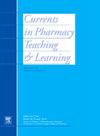Taking the plunge together: A student-led faculty learning seminar series on artificial intelligence
IF 1.4
Q3 EDUCATION, SCIENTIFIC DISCIPLINES
引用次数: 0
Abstract
Objective
This pilot study explored the effectiveness of a student-led faculty development series by evaluating two key outcomes: the capacity of students to deliver meaningful professional development sessions to faculty and the impact of these sessions on faculty perceptions of generative artificial intelligence (AI).
Methods
In a flipped classroom model, two pharmacy students and 12 faculty members engaged in a semester-long learning series on AI. Each week, students presented on a selected topic followed by discussions that facilitated self-directed learning, including decision-making and project management. Faculty perceptions of AI were evaluated before and after the series using an anonymous survey tool (Technology Acceptance Model Edited to Assess ChatGPT Adoption, TAME-ChatGPT). Respondents created a self-chosen code to link their responses. Additionally, students completed a questionnaire to gauge their reflective thinking after the series.
Results
Faculty participation averaged 7 members per session. Twelve faculty completed the pre-survey, while 8 faculty completed the post-survey. Among those who had used ChatGPT (n = 4 pre [33 %], n = 2 post [25 %]), scores for usefulness increased, while concerns about risks decreased. In contrast, faculty who had not used ChatGPT (n = 8 pre [67 %], n = 6 post [75 %]) reported unchanged or improved scores for ease of use and reduced anxiety. Both students responded positively to the reflective thinking questionnaire.
Conclusion
This pilot study demonstrated that a student-led faculty learning series effectively fostered mutual collaborative learning, benefiting both faculty and students. Pharmacy students, often an underutilized resource, can play a valuable role in faculty development. Colleges of pharmacy may enhance faculty engagement by integrating student-led initiatives into their programs.
一起冒险:一个由学生领导的关于人工智能的教师学习研讨会系列
本试点研究通过评估两个关键结果来探索学生主导的教师发展系列的有效性:学生向教师提供有意义的专业发展课程的能力,以及这些课程对教师对生成式人工智能(AI)的看法的影响。方法在翻转课堂模式下,两名药学学生和12名教师进行了为期一个学期的人工智能系列学习。每周,学生们就一个选定的主题进行演讲,随后进行讨论,促进自主学习,包括决策和项目管理。使用匿名调查工具(技术接受模型编辑以评估ChatGPT的采用,TAME-ChatGPT)在系列之前和之后评估了教师对人工智能的看法。受访者创建了一个自己选择的代码来链接他们的回答。此外,学生们还完成了一份调查问卷,以评估他们在系列节目后的反思性思维。结果每期平均有7名教师参与。12个学院完成了预调查,8个学院完成了后调查。在那些使用ChatGPT的人中(n = 4前[33%],n = 2后[25%]),有用性得分增加,而对风险的担忧降低。相比之下,未使用ChatGPT的教师(n = 8前[67%],n = 6后[75%])报告在易用性和减少焦虑方面得分不变或提高。两名学生对反思性思考问卷的回答都是积极的。结论本初步研究表明,学生主导的教师学习系列有效地促进了相互协作学习,使教师和学生都受益。药学专业的学生,往往是一个未充分利用的资源,可以在教师发展中发挥宝贵的作用。药学院可以通过将学生主导的倡议整合到他们的项目中来提高教师的参与度。
本文章由计算机程序翻译,如有差异,请以英文原文为准。
求助全文
约1分钟内获得全文
求助全文
来源期刊

Currents in Pharmacy Teaching and Learning
EDUCATION, SCIENTIFIC DISCIPLINES-
CiteScore
2.10
自引率
16.70%
发文量
192
 求助内容:
求助内容: 应助结果提醒方式:
应助结果提醒方式:


